#LoZ Analysis
Explore tagged Tumblr posts
Text
Something I love about the memory of Zelda and Sonia in the German dub of TotK...

(Translation: And your Link, too, is surely awaiting your return.)
Sonia uses the phrase "dein Link" ("your Link") here, which in German is a common phrase to indicate the belief that someone might have romantic feelings for another person. And the way Pauliner Weiner (Sonia's German VA) delivers this line very much indicates that she is indeed teasing Zelda a little here! Sonia ships Zelink confirmed!!
But wait. There's more!
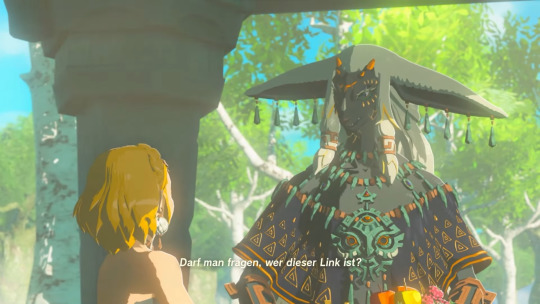
(Translation: May one ask who this Link is?)
Rauru definitely notices this too! His tone, as well as the use of the very specific article "dieser" ("this") indicate as much. If he was simply curious about who Link is in order to follow the conversation, he would more likely use the phrase "Darf ich fragen, wer Link ist?" ("May I ask who Link is?"). He is also teasing Zelda a little here.
Zelda's reply is also very sweet! While her first two lines are nothing special (she is essentially just recapping the events Breath of the Wild, as well as what led up to it), it gets interesting once Rauru reacts to her description, once again in a somewhat teasing manner (indicated by both the delivery and the language of the line):
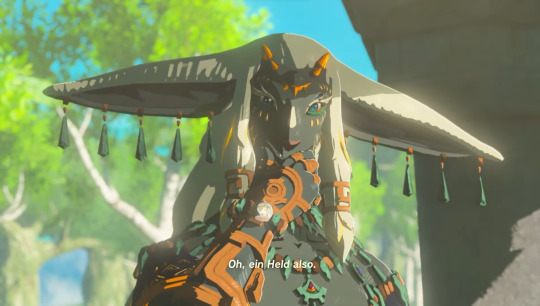
(Translation: Oh, a hero you say.)
To which Zelda replies with:

(Translation: Link is the most steadfast and fearless knight who ever existed.)

(Translation: Yes...)
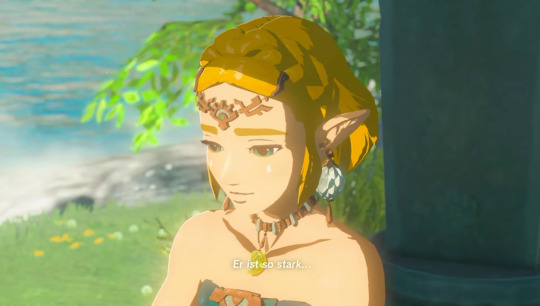
(Translation: He is so strong...)
That last line is pretty much the same in English, but Julia Casper (Zelda's German VA) does an amazing job making it sound like Zelda is not only admiring Link throughout this entire short monologue she is having, but like she is talking more to herself than to Rauru and Sonia, almost like she forgets they're there for a moment because she is thinking about Link. I really loved this little touch!
Also note that Zelda is not explicitly talking about physical strength in the last line (although she might be. It isn't clarified, leaving the interpretation of what kind of strength she is talking about up to the player).
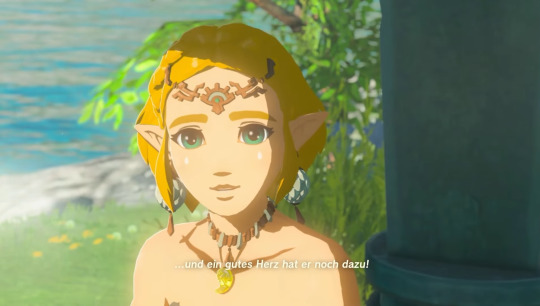
(Translation: ... and on top of it all, he has a good heart!)
This last part seems to be directed at Rauru and Sonia again. But we're still not done!
After Rauru remarks that Zelda seems to think highly of Link and that the way she's talking about her knight makes him want to meet him, Sonia agrees and delivers a final line that, once again, makes it very clear that the two of them are engaging in a little bit of good-mannered teasing in this scene (both from what's actually said here and how Paulina Weiner delivers the line):

(Translation: Chivalrous, and full of gallantry...)
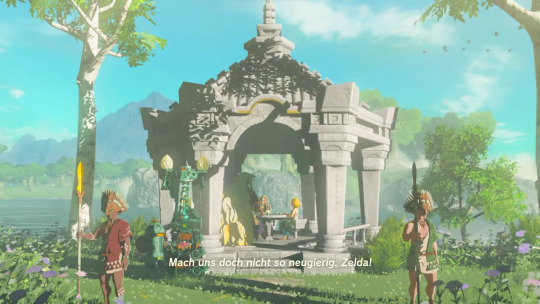
(Translation: Don't make us so curious, Zelda!)
And then they all break out in light-hearted laughter.
All in all, I really love this scene! Huge respect to the German VAs, who did an absolutely stellar job (not just in this scene, but for the game in general - especially Julia Casper!).
#The Legend of Zelda#Tears of the Kingdom#TotK#LoZ#Meta#Legend of Zelda#LoZ Meta#Analysis#LoZ Analysis#German#German dub#Zelink#Zelda#Sonia#Rauru#Currantlee here#Currantlee translating
2K notes
·
View notes
Text
Echoes of Wisdom: Timeline Placement

First, we need to remember that the Zelda timeline was updated in 2017 in the Hyrule Encyclopedia. With that update, the Links that are the "same" in each game were updated. The Hyrule Hystoria timeline many are familiar with is from 2011.
Here we can see: ALTTP/LA = 1 Link OoS/OoA = 1 Link ALBW/TFH = 1 Link

Maps: Close to each other but not exact. Very close to EoW and I've seen quite a few posts of similarities floating around so I'll move on. ALBW has a statue in the field or rocks while ALTTP doesn't, for example. OoA/OoS maps not relevant.

Ganon's similarities across the existing games to EoW are pretty easy to see. He's got elements of all of them.

Next up is Zelda:

ALTTP and ALBW designs are very similar to each other, but not exact. Oracles Zelda also has some similarities, but stands out a bit more.

Now look at all these similarities! At first you'd assume she's the same Zelda as ALTTP or ALBW, but that pesky purple girdle? girl-loincloth? Anyway, that's on OoA/S Zelda. Once again, her starting outfit is a mix of all three games.
Where does that leave us? With a high chance that Echoes of Wisdom is a new Link and Zelda, sitting somewhere before or after Oracle of Seasons/Ages.

#Echoes of Wisdom#eow#The Legend of Zelda#Loz#Zelda#legend of zelda#Nintendo Direct#timeline#zelda timeline#eow theory#loz analysis#breannasfluff
182 notes
·
View notes
Text

the craziest thing about this quote i find is, again, not only is this Not touched upon in the game in the slightest, but how totk actively goes against this. i find it genuinely odd how going back in time to see her ancestors is “what changed her mind”
because if we think about this. right. with the fall of the kingdom after the calamity and the destruction of the castle and the castle town, zelda choses to put her people first and channel all of her energy into rebuilding the World rather than rebuilding the Monarchy. she chooses to rule amongst her people rather than Above in a fancy castle, something which the npcs in totk illustrate works so much better because of how much they love and adore her. zelda has so much more influence over her people and can help and do so much more as a princess on the Ground without any royal escorts breathing down her neck telling her what is and isnt a good idea. which directly shows that hyrule as a kingdom is stronger and much more united without an official monarchy. because people come together at the disappearance of link and zelda to find them, they build lookout landing specifically for it and work together to keep each other safe through the motivation of finding their heros because they’ve actually been given the chance to know them rather than a figurehead of them. in botw nobody really knows how to protect themselves, only a few travellers brave it in the wild and the majority stay comfortable in their towns until monsters start trying to intrude, but then in totk, after zelda’s Direct influence, they band together to protect one another AS WELL AS link and zelda. the people want to protect them because of how personal zelda’s help is
she has more power as a wandering princess than stationed in a castle!!!!!
pre calamity we know that realistically most people wouldnt have even known what she looked like, nor what she wanted for the kingdom or even her character since it was constantly getting smeared by gossipers around the castle, which would inevitably spread around. she was hidden behind doors in the castle as True Royalty and thus struggled to have any real impact on the world like she so desperately did. she tore herself to shreds trying to awaken her power just so she could help her people because there was nothing more she was allowed to do to help. and you’re telling me she would willingly choose to rebuild the monarchy and the kingdom as it was beforehand knowing that she can do so much more to help without the constraints of royalty??? doesn’t that just disregard all of her character development?????????
god knows if any of this makes sense
#jester rants#fujibayashi is getting on my nerves#legend of zelda#loz link#loz zelda#tears of the kingdom#zelda and link#link#princess zelda#zelda tears of the kingdom#totk spoilers#totk#loz analysis
425 notes
·
View notes
Text
Oh shit. In the legend of zelda Majora’s Mask, the game is in four sections.
The first section, you have the Deku mask, created from the spirit of the Deku Butler’s son, who died a long time ago, and you only realise it after you’ve already met those who knew him.
The second section, you have the Goron mask created from Darmani. He died just recently, to the point where you can convince the gorons that he never died at all.
The third section is the Zora mask from Mikau, who you meet just before he dies.
Each time you meet a character, it’s just too late to save them, but as you go on through this journey, the time you miss them by, shrinks. You get closer to being able to save someone.
And in the fourth section of the game, you play the song of healing and you do save someone. Pamela’s father got to live on with his daughter.
It’s just nice that the first 3 transformation masks were created by those you couldn’t save, and the last mask, the fierce deity mask, was made up of the gratitude of all the people you did save.
#i am so insane about this game#I’ll never be okay about it#loz#the legend of zelda#majora’s mask#loz mm#loz analysis#??#tw fictional death#is that a tag?
63 notes
·
View notes
Text
A Brief (and not at all comprehensive) Analysis of Triforce Lore in Breath of the Wild and Tears of the Kingdom
The Triforce is such a massive piece of Hyrule's lore that it's been the focal point in every single Hylian royal crest in the games so far. Despite that, it's never mentioned by name in Breath of the Wild or in Tears of the Kingdom. Of course we see the Triforce on Sonia's tattoos (skin paint?) and when Zelda used magic in BotW, but the symbolism of the three aspects was furthered between BotW and TotK in interesting ways. Here's your warning for mild spoilers about the labyrinths and the Zonai armor set.
For those of you new to the franchise (and those who'd like a refresher), the Triforce is that fun triangle symbol made of three triangles forming a fourth with their points. Each of the triangles represents Courage, Wisdom, and Power, respectively. In BotW, we got a sacred spring for each aspect of the Triforce, though the Triforce itself is never mentioned. In the Zonai ruins in Faron we see carved dragons and owls and even the occasional boar, and it's easy to draw the meaning. Owls are often associated with wisdom, Ganon (the historical bearer of the Triforce of Power) often takes the form of a large boar, and dragons are scattered throughout various mythologies in stories of courage. The Zonai were clearly very aware of this symbolism and its history in Hyrule.
Tears of the Kingdom, while still not mentioning the Triforce by name, takes this even further. One hint we see, when looking closely, is that the Zonai armor chest piece has ornamentation made up of three mask-like objects, bearing resemblances to an owl, a dragon, and a boar. When beginning the quest at each set of labyrinths, Link hears a voice speak to him. These three voices claim to be the Ruler of Owls, the Ruler of Dragons, and the Ruler of Boars. Each labyrinth comes with a task that tests all the aspects of the Triforce: wisdom to locate the terminals, courage to dive into the depths, and power to defeat the enemy at the end.
What I find interesting is that Link is repeatedly tested on all three aspects—not only courage, which has historically been associated with the Hero. Considering Zelda attended and prayed at all the springs during BotW's story, and she bore the mark of the Triforce when sealing Dark Beast Ganon, I wonder whether the Triforce now exists more as a spiritual concept than a physical artifact. Link, who is continually proving his proficiency in all three aspects, bears his own Triforce in a way, living within a balance of the three just as Zelda has. This, essentially, makes him worthy of bearing the Master Sword, just as it makes Zelda worthy to wield the Sealing magic.
While this is a fun theory, it still stings that the Triforce has seemingly been ignored in the recent lore, and feels a bit reminiscent of the same treatment of the Golden Goddesses, who each created one aspect of the Triforce. They are not mentioned at all in BotW or TotK, save in veiled references by way of the dragons' names and names of regions: Naydra and Lanayru (Nayru), Farosh and Faron (Farore), and Dinraal and Eldin (Din). I've seen it mentioned that Nintendo may be trying to appeal to their Western audience by angling the franchise toward monotheism—which is a whole other discussion I'm not at all qualified for, but I'm mentioning it here for its vague relevance. It's disappointing, to say the least, and that the Triforce has been set aside along with the Golden Goddesses gives me cause to mourn a little. Here's hoping the next game brings them back in more substantial ways than vague references.
#the legend of zelda#legend of zelda#tloz#breath of the wild#tears of the kingdom#botw#totk#Triforce#triforce lore#zelda lore#loz analysis#loz theory
36 notes
·
View notes
Text
Moludga - Gerudae molduga molduga and Molduking - Gerudae molduga centusomnus


10 notes
·
View notes
Text
Translation Shenanigans: Part 3
Hey everyone, welcome back to BotW translation chaos, except it’s not BotW, it’s TotK! This is a collection of all the different trailers for the game with a side by side French/English translation comparison and analysis via myself and @twist-dg!
Trailer #1:
There’s… no dialogue…
Trailer #2:
Frn!Ganon: Montrez-vous, mes fidèles serviteurs. Mettez le royaume à feu et à sang. Detruiser Hyrule, et quiconque s’allierait à sa cause. Ne laisser aucun survivant!
Which directly translates to: Show yourselves, my faithful servants. Put the kingdom to fire and blood. Destroy Hyrule, and whoever would ally themselves to their cause. Do not leave a single survivor!
Eng!Ganon: Rise, rise my servants. Sweep over Hyrule; eliminate this kingdom and her allies. Leave no survivors!
Analysis:
Frn!Ganon calls his servants faithful, where Eng!Ganon does not.
—
Frn!Zelda: Mais Link, puissant come il est, je craint que tu ne puisse pas le vaincre.
Which directly translates to: But Link, he is so powerful, I fear that you won’t be able to vanquish him.
Eng!Zelda: …but Link, I am not sure you’ll be able to stop him.
Analysis:
Frn!Zelda mentions Ganon is powerful, Eng!Zelda does not. This line appears to be in the middle of a larger section of dialogue.
—
Frn!Zelda: Je t’en prie, confie-lui le don que tu possède!
Which directly translates to: I beg you, entrust him with the power you have!
Eng!Zelda: Please… lend him your power!
Analysis:
Frn!Zelda uses informal pronouns, English doesn’t have that differentiation.
Trailer #3:
Frn!Zonai Sage?: Zelda. Il restera ton chevalier, le jeune homme à la lame purificatrice. Si nous échouons, tout reposera sur lui.
Which translates directly to: Zelda. He will remain your knight, the young man with the purifying blade. If we fail, all will rest on him.
Eng!Zonai Sage?: Zelda. We rely on your knight, and that legendary sword he carries. Our last line of defence will be Link.
Frn!Zelda: Link..!
Eng!Zelda: Link..!
Analysis:
Frn!Zonai Sage? mentions the possibility of failing, who the “we” is remains to be seen (them and Zelda, them and the Zonai, them and PAZ?).
—
Frn!Zelda: Je pense pouvoir vous aidez. En faite, je suis la seule à pourvoir le faire.
Which directly translates to: I believe I am able to help you. In fact, I am the only one who can do this.
Eng!Zelda: I know why I am here. It’s something only I can do!
Analysis:
Frn!Zelda seems more unsure of herself; she says “I believe” where Eng!Zelda says “I know.”
—
Frn!Ganon: Ouvre grand les yeux. Le véritable roi renaît. Sois témoin de l’avènement de son monde. DreahhHHHHGGG!
Which directly translates to: Open your eyes wide. The true king is reborn. Be witness to the coming of his world. DreahhHHHHGGG!
Eng!Ganon: Do not look away. You witness a king’s revival… and the birth of his new world! NrauRAHGGGGGGGG!
Analysis:
Potential parallel between Frn!Ganon saying “open your eyes wide” and Zelda saying “open your eyes” at the start of BOTW.
—
Frn!Tulin: Allez Link! On y va!
Which directly translates to: Come on Link! Let’s go!
Eng!Tulin: Okay, let’s go!
—
Frn!Riju?: Toutefois, tu n’es pas seul justement.
Which translates directly to: Nevertheless, you are not alone
Eng!Riju?: …but, you are not alone.
Analysis:
We have NO CLUE who this is, but it might be Riju (or PAZ???) since she is shown around this time in the trailer and seems to be older. This line appears to be in the middle of a larger dialogue.
—
Frn!Zelda: Link… tu est notre dernier espoir.
Which directly translates to: Link… you are our last hope.
Eng!Zelda: Link… you are our final hope.
—
Frn!Zelda: Link… je t’en prie, retrouve moi!
Which directly translates to: Link… I beg of you, find me!
Eng!Zelda: Link… you must find me.
Analysis:
Once again, Frn!Zelda is a bit more dramatic/passionate when she speaks; she has more of a flourish with her words.
Bloopers:
“Gamon”
That’s it, that’s the bloopers.
#LoZ#LoZ analysis#totk spoilers#TotK#tears of the kingdom#Pancake translates LoZ#for y’all wondering who Paz is#she’s the mysterious lady from the trailer (Probably Ancient Zelda)
7 notes
·
View notes
Text
The infamous oot sibling theory
(and how its manga encouraged it)
▰▱▰▱▰▱▰▱▰▱▰▱▰▱▰▱▰▱▰▱▰▱▰▱▰▱▰▱▰▱▰▱▰▱▰
• table of contents ��
a) the problem
b) the theory
c) thoughts
▰▱▰▱▰▱▰▱▰▱▰▱▰▱▰▱▰▱▰▱▰▱▰▱▰▱▰▱▰▱▰▱▰▱▰
a) the problem
I recently got back to reading the Ocarina of Time legendary edition manga that I already had at my disposal and while rapidly going through it, I suddenly noticed an odd panel on one of its pages.
For those who also have the manga, the panel in question was specifically on page 113.
For those who have the Ocarina of Time’s volumes all separately, it was in chapter 6 of “Ocarina of Time”.
In this chapter, Link has finally woken up from his sleep of seven years and has been told by one of the sages, about what the world has been like during his absence.
Right after his explanation, however, the sage finally reveals to Link where he truly came from.
Instead of being a kokiri, Link was in actuality a hylian.
So far, everything was told correctly.
Or so it should have.
Because in that revelation scene, exists two completely different meanings attributed to Link’s origins.
There seemed to be some kind of mistranslation or misassumption between the online version and the book version.
In the online version, right after the sage explains to Link, that he’s a hylian and not in actuality a kokiri, he specifies that he has hylian blood just like princess Zelda.

It wouldn’t be weird for the sage to mention Zelda when talking about hylian blood since she was the first hylian who Link managed to have a full conversation in his life with (not to mention spent a full day with her in the manga), so the sage would of course name her as a hylian example.
But as for the physical book, however…
The wordings of this same scene have a completely different meaning.
Instead of telling Link that he has hylian blood, the sage tells him that he has ROYAL hylian blood flowing through his veins just like the princess.

What is especially peculiar here is that the physical book claims that Link and Zelda are related by BLOOD while the online version simply tells Link he’s of Hylian descent like princess Zelda.
The fact that both are claiming two different things is a huge problem.
Mainly for two reasons.
Number 1, the physical book translation came straight from the book and not from its online counterpart meaning that if you took your own Ocarina of Time manga from your bookshelf and went to page 113 (or on chapter 6 depending on which edition you have), you would find this same bubble on your manga as well.
Number 2, the online version of the manga makes much more sense during this scene than its book counterpart which shouldn’t happen in any kind of situation whatsoever.
The book should always be better than its online one.
I would’ve never pointed out that mistake if the mistake itself came from the online version and not the actual book.
So in short, the problem here is that the official translation messed up a simple part to make, as well as contradicted the lore surrounding Link’s origins.
I am unaware of how these kinds of mistranslations can happen in the first place but did the people responsible for the translation see this obvious mistake?
Two separate occasions would have made the translators realize their mistake by simply examining the book closely.
1) The revelation got repeated by Link himself.
If we go ahead and scroll through the online book version to end up on page 270 (or chapter 6 of “Hero of Time”), Link tells Sheik the same thing that the Sage told him once he awakened from his sleep.

But then, when we look back at the actual book again, Link also said the same thing even though he got told by the Sage that he was related by blood to Zelda.

2) Link’s parents.
As soon as the Sage reveals to Link his origins, he then explains who his parents used to be before their unfortunate deaths.
In the online version, his father was one of the Hylian Knights who were an elite clan of warriors tasked by the King to fight back against Ganondorf’s army.
He dies in battle while his mother was a noble who escaped the war by fleeing the mansion they lived in but tragically dies in the lost forest due to a severe wound that she received.

Although the book’s interpretation was an error, this did not stop some fans to speculate on what the book was implying about the duo bearing the triforce of wisdom and courage.
However, there was another case in the manga that could have pushed some fans to believe that Zelda and Link may have been siblings.
And that was during the same moment when the Sage revealed to Link his true origins.
And yet again, we have had two different meanings from the book and the online version.
In the book, while the Sage was revealing to Link his true origins, he mentions how his mother fled a palace to escape the war and flee towards the forest.

Usually, when one thinks of a palace, they think of a castle meaning that some people would’ve presumed that Link’s mother must’ve been the queen of Hyrule.
We could have also suspected that she must’ve been some kind of noble who was some sort of guest to the royal family which would explain why she’d be fleeing a castle but that would be too much of a far-fetched idea given the fact that it has no solid proof to back it up.
We are aware that Link’s mother was some kind of noble. So it would’ve been more logical to insert the word “mansion” instead of “palace” as how the book’s online counterpart did.
b) the theory
There was a time when a wild theory was circulating in the fandom that was so weirdly controversial, that people have surprisingly taken two major sides for it back in the day.
I’m sure you’ve also heard of it by now.
The theory on whether or not Link and Zelda from Ocarina of Time are in fact siblings.
Or at least secret siblings.
Yes. This widely hated theory originally came from the game and the manga right afterward.
But I believe that the manga further pushed that theory to be more believable to some few fans who already acknowledge it to be true due to the inconvenient book mistranslation.
Please bear in mind that the theory that I’m about to explain will only be applied to Ocarina of Time and is in no way a hypothesis that I believe in. I am also in no way criticizing anyone who truly believes in this theory.
Any other LoZ works that have shown any kind of sibling hints between the two will be ignored.
The theory goes like this:
• It is very plausible that princes in the royal family can happen from time to time.
A great example of this would be the prince of Hyrule in “The Adventure of Link” from the Decline timeline.

So it wouldn’t be impossible to think that Link might be Zelda’s twin brother.
• Link and Zelda, two hylians bearing two pieces of the triforce, were twins who have been separated at birth due to the war going on back when they were both still merely newborns.
• Their mother, the queen of Hyrule, was only able to have taken Link, her son, and rushed him out of the chaos while the King of Hyrule decided to stay in the castle and keep his daughter Zelda with him in hopes of keeping her safe deep in Hyrule’s walls while the war was going on.
• The queen of Hyrule entrusts her son to the Deku tree in hopes that he’ll be able to take care of the prince in her stead and with one final last breath, the queen dies from her injuries.
• The king, having lost his wife as well as his son, decides to put Impa in charge of his daughter’s safety whenever he won’t be able to do so himself. This will lower the chances of having his daughter be taken away from him if she ever ends up getting in danger.
• As the two royal children get to grow up while being apart from each other, certain similar physical features start to show on both children. This will result in Link and Zelda having the same hair, same eye colour, and same skin complexion.
• When Zelda learns of her heritage as well as the fact that she used to have a twin brother, she becomes more responsible and active in her role as princess and starts her studies to ensure the prosperity and safety of Hyrule.
• Link, on the other hand, is unaware of his true origin as prince of Hyrule and spends his days as a kokiri, simply having fun during his childhood.
• When the two eventually meet for the first time, they proceed to end Ganondorf‘s future destruction of Hyrule only to then realize that they have failed which will result in Link getting into a deep sleep and Zelda turning into a boy and hide her true identity for seven years.
• When they eventually succeed in killing Ganondorf as their adult selves, Zelda thanks Link for going through all of this and she decides to make him return to his childhood where he could make up for those seven years.
• The two meet in their childhoods, get to call out Demise’s reincarnation and even after all that, they do not realize their connection and come back to the day they met forever unaware that their blood connection will never truly be revealed to both of them.
Now that I completely explained the theory in its entirety, here’s why the majority of the fans do not believe in this theory they call far-fetched.
1) Link and Zelda’s parents are two completely different sets of people. Zelda’s parents were the king and queen of Hyrule while Link’s father was a Hylian knight and his mother was a noble.
2) Just because Link and Zelda have similar physical traits such as having the same eye colour, hair and skin, this does not signify that they share any similar blood. Plenty of hylians no matter if they’re nobles or commoners have matching physical resemblances so this means nothing.
3) There is no relation or proof that Link is a prince just because the royal family can have males. Although it is true and may be possible for Link to be a royal, the one from Ocarina of Time just simply does not click with that possibility since he comes from a family who’s sole purpose is to serve the Royal family.
c) thoughts
This whole situation is extremely messy from my perspective on the matter.
Whether the mistranslations were even mistranslations at all or were translations believed to be accurate by the translators is irrelevant to me.
No matter whose side is the correct one, we can all agree that the book version should ALWAYS be better than its online counterpart. NEVER the other way around.
I mean it’s mind-boggling to me how people can expect to see this and not bat an eye at it.
I’ve never personally seen the original version of a topic that has more errors than its fan version which has the most probable chance of getting more mistakes than the original.
There was just so much I wanted to cover about the book, the whole Ocarina of Time to be exact.
From its ridiculous amount of book mistakes to a widely known theory that is far-fetched, this was very weird to notice and I’m sure a lot of you guys have probably realized it before even coming here.
I also wonder if some fans still believe this sibling theory for Ocarina of Time.
If some do still believe that, then that’s great. Great because that’s very surprising.
(PS: The whole ocarina of time manga should’ve been traumatizing to read.)
(PPS: OoT’s manga really made me start shipping Sheik and Link together when I was just a kid. That was literally the first *and only* yaoi ship I’ve ever truly liked. Now that I look back on it, my love for it is slowly resurfacing 🥰 like come on man no amount of logical explanation will make me believe that there’s nothing gay about this page alone)

#loz#legend of zelda#loz manga#loz link#loz zelda#loz ocarina of time#legend of zelda ocarina#legend of zelda ocarina of time#legend of zelda ocarina of time manga#loz ocarina of time manga#loz analysis#loz rants#loz rant#the legend of zelda#the legend of zelda manga#the legend of zelda anime#the legend of zelda theory#loz oot#loz oot manga#loz theory#loz oot theory#legend of zelda theory#legend of zelda theories
2 notes
·
View notes
Text
Considering this scene is kinda the climax of the story’s “main” conflict:

Yeah, “consent” seems like the real take-home message here.
More random Hyrule Warriors thoughts:
Due to one portion of the game, people tend to focus on pride as the major theme of the game. I strongly disagree with it, because it is literally only featured in one portion of the game. I would argue that instead an accidental theme of the game is CONSENT.
Link has no voice in this game. It is overtly stated that Proxi speaks for him.
There is no choice in being Hero. In this game, when it's discovered that he's the Hero, he's immediately elevated in rank without his say. It's stated that he didn't feel worthy of it, but he would try his best. He is thrust into the spotlight and slammed with the responsibilities of Hero like very few Heroes are.
A major plot point is Cia's obsession with him. His say doesn't matter. His revulsion doesn't matter. She's an ancient sorceress and who knows how long she has been watching Link. I doubt she saw him and decided to attack his era the next day.
Another bit is the emphasis on how the Hero and Princess are destined for each other. Zelda has far more autonomy in the game than Link through her use of the Sheik disguise. It feels like "Of course Cia isn't an option: he's destined for Zelda!" Link's opinion? Who knows.
His soldiers turn traitor on him. They get to choose their side, turning on Link for something which isn't his fault and for something which counts him as a victim in the war. I see it as a popular theme in fanon: Link was the cause of the war. Not Ganon with his chosen actions. Not Cia. Link.
The major choice he made was at the beginning when he chose to run out onto the field and join the battle. Soon after, Proxi found him, made the comment about how quiet he was, and the rest was history.
Almost every Hero got some sort of choice at the beginning of their Hero's Journey. They COULD have turned away. This Link didn't get that choice. He didn't get any choices regarding his role in the war, Cia's obsession, how his soldiers-turned-traitor viewed him. And what everyone remembers about this Link is not that but the moment he gave into his pride. Ow.
#that said it is really interesting to me that hw!link is kinda the only iteration with a canonical ‘character flaw’#presumably because it’s less important for him to be a blank slate#‘pridefulness’ is absolutely not the sum of his character but it’s cool that he gets to HAVE a non-positive characteristic#his canonical voicelessness is also particularly interesting to me#op should know that these hw analyses have been instrumental in my mission to make warriors fans of my zelda irls#and they’ve also directly shaped the way I think about the hero’s spirit so#thanks so much for sharing!#loz analysis#loz hw
408 notes
·
View notes
Text
Majora's Mask and what it means to be grown up
(aka my collected analysis of the Legend of Zelda Majora's Mask)
I will say that generally I don't think Termina is purgatory, or a dream, or anything like that. To me, Termina is kind of like a Silent Hill type parallel world, where you face your deepest traumas.
First, the parallels between Majora's Mask, and the child section of Ocarina of Time.
The first dungeon for both games is in a vast wooded area, there are woodland races inhabiting both areas, the Kokiri for Ocarina of Time, and the Deku for Majora's mask. The second dungeon is in a great mountain, inhabited by the Gorons. The third dungeon is in a vast body of water, inhabited by the Zora.
Then, things split. After Jabu Jabu, Link becomes an adult. After Great Bay, there's Ikana Canyon. A land of nothing but Death.
Who caused the death of Ikana? Who else but the king, Igo Du Ikana. Ikana was plunged into disrepair, after Igos started a war with a clan of Ninjas, to receive a powerful artifact, in a great and mysterious temple. Sound familiar? It should, this is exactly what Ganondorf did, after Link was sealed away for seven years. But Ganondorf was successful.
But Ikana isn't completely occupied by the dead, no. Pamela remains, with her father, turned into an undead monster. Much like Sheik, the last Sheikah, who is revealed to be Zelda. And her father? He's never seen, but I'd imagine it would be easy enough for Ganondorf to become king, if the other one was no longer around. From a man, to a corpse.
So, if Ganondorf is a parallel to Igos, and Zelda is a parallel to Pamela, what about Link? He's a little different. I believe that, along with Kafei and Tingle, all three of the transformation masks are a representation of Link, and his feelings towards being forced to grow up.
Tingle is, as we know, a 35 year old man who thinks he's a fairy boy. Similar to how link was a 10 year old boy, who thought he was a fairy boy. I believe Tingle is a reflection of what Link could have been if he never left Kokiri Forest. An adult hylian man, thinking he's a Kokiri.
On the contrary, Kafei is distraught at the idea of becoming a child again. He's weaker, he can't marry his fiancee, and everyone treats him like well, a child, despite his maturity. I believe this is how Link feels after becoming a child again. He used to be a strong adult, and even if he's not as mature as Kafei, he still went through a lot, and knows a lot more about life now. Kafei even reuses Link's model and animations.
There's a reoccurring theme in Ocarina of Time where Link just doesn't belong anywhere he goes. He's an outsider to the other races, because he's a hylian, but he's also an outsider to the hylians, because he was raised as a Kokiri. I think the transformation masks reflect that.
The Deku Butler's Son is what he could have been as a Kokiri. He could have been a happy little boy, living with his father, and his community. But Link and the Deku butler's son both left home to explore, and as far as both the Kokiri and the Deku are concerned, neither came back.
Darmani is what he could have been as a Goron. A powerful hero to the Gorons, celebrated by them for clearing Dodongo's Cavern. A close link between the goron elder, Darunia, and their sons. Both him and Link remain after death, lamenting on their histories as heros.
Mikau is what he could have been as a Zora. Maybe not a cool as hell guitarist, but a husband to Ruto, and Prince of the Zora Who would stop at nothing to keep her happy and safe, like infiltrating a fortress, or climbing inside of a whale.
Even the Fierce Deity is just Link, but back as an adult. As if so much changed so rapidly, he felt like he transformed into something less like himself, and more like a powerful god. He could have continued being strong, and powerful, the defeater of Ganon, but he had to become a child again. He has to stay as a small, and unknown child.
The ages of the masks even match the human life cycle. According to the debug menu (and if you subscribe to the theory that Link and DBS's ages were swapped), DBS is 5, Link is 12, Darmani is 30, Mikau is 78, and, Fierce Deity is 17, likely due to his model being recycled from adult Link's. Link starts the game in the body of a 5 year old, then a 12 year old, then a 30 year old, then a 72 year old, and finally, a God.
We don't exactly know how Link feels. But I can't imagine it would be easy to go from a child, with no concept of death, to be thrust into a position where he's forced to fight and kill an adult man so much stronger than he is. And then everything was just reversed. Like that. As if it never happened. And only Link remembers the impending doom he faced. All he can do is remember Ganondorf's reign. Almost like he's reliving the same few days, again, and again, and again.
588 notes
·
View notes
Text
Trying to figure out TP Link's diet based on his environment.


Livestock-wise, we've got cuccos and goats. That means
Eggs
Milk
Butter
Cheese
Potentially meat, but I don't think they get eaten unless they're old. Too valuable otherwise | EDIT: Oh yeah you need to breed goats every couple years to get milk. Add in cabrito veal!
And we know for a fact that Ordon Goat Cheese specifically is a thing. Stamped wheel and everything.

There's also fish

And bees/hornets(? It's called bee larva, but the enemy is a Hylian Hornet)

Useful for bait, but Link can eat them.
Did some more research, and apparently in Japan they eat wasp larvae? Specifically in Kushihara. So I'm counting it.

Then plants-wise we have pumpkins

And...corn. Somehow. I've never seen corn growing, but Link has some hanging in his house, so it exists.

I'm choosing to believe it comes from these plants that grow in patches around Ordon.
That gives us a lot. We've got
Cornstarch
Cornmeal
Corn oil
Corn shoots
Pumpkin seeds
Pumpkin seed oil
Pumpkin flour
Pumpkin blossoms
No source of sugar, but depending on how the pumpkins in Ordon taste, they could be naturally sweet. Like pie pumpkins. Also corn syrup is a thing if it's a sweet corn. So corn syrup needs cream of tartar which comes from grapes and apples and such. It's a byproduct of wine. No corn syrup.
Edit: Malt sugar, though!
Now for hypothetical foods.

Ordon is surrounded by pine trees, so that adds pine needle tea and pine nuts to the mix. I was a little worried about species, but apparently there are a lot of pine trees that make edible seeds, so on the list it goes.



Then there are frogs near Rusl and Uli's house, wild songbirds on cliffs, and a squirrel that talks to Link directly, so those are huntable sources of meat.

Is horse grass a cattail? Maybe? Initially, I thought it was—the ends look like cattail seedpuffs, but the leaves are completely different.
I want to treat them like cattails. Cattails that also are probably the main food source for Epona and the goats.
If we do that, that means, on top of all the other uses cattails have like stuffing and tinder and antiseptic, we get
Roots
Shoots
Ground seeds
Can't find a good match for hawk grass though. Concluding that that's not edible. Equivalent exchange and all.
Side note, how do you think horse grass spreads? It's almost always in groups of two or more plants, so that suggests rhizomes, but the image of Link picking one up to blow and stuffing flying out the end of the horseshoe is hilarious to me.


Up next, there are ferns, primarily near trees. After very careful and way-too-deep analysis of a pixelated fern's leaves, I think it's bracken fern.
Which is mildly poisonous.
And also edible.
On the list it goes!

Then finally, Sera has some kind of herb hanging in her shop.
I don't know what it is. I'm calling it Ordon Spice. Congratulations, Ordon Pumpkin Spice is now a thing.
#long post#twilight princess#loz#zelda#analysis#theory#worldbuilding#hello it is bee being a nerd about zelda hours again
762 notes
·
View notes
Text
Ganondorf in German Tilo Schmitz Appreciation Post
The first cutscene of TotK is defining for Ganondorf as a character. I played the German version of the game, and the dub does a stellar job with this scene! It is very memorable IMO, and it instantly sets Ganondorf up as a somewhat stereotypical antagonist, but a serious threat nonetheless. It's one of my favorite scenes in the game, and that is also because Ganondorf's German VA, Tilo Schmitz, does an absolutely stellar job! It's great that he's getting the recognition he deserves for this performance!
Each line of Ganondorf's monologue in this scene is packed with (character) exposition, both textwise and deliverywise, but you don't even notice because you're in too much awe - at least that's my experience with the scene (in German).
Sooo... I wanted to take a closer look at how exactly both the scene and the voiceacting accomplish this.
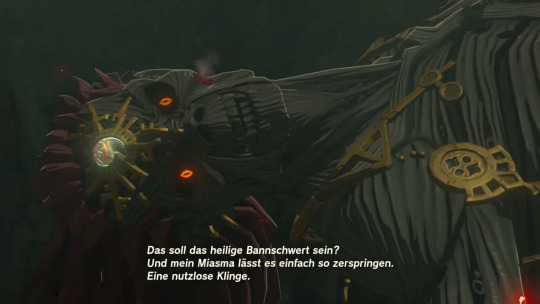
Translation: That is supposed to be the sacred banishing sword? And my miasma shatters it just like that... A useless blade. English Localization: Was that the sword that seals the darkness? A blade that shatters so easily against my power cannot save you from me.
A few things about this line (and the rest of the scene) under the cut, because I'm gushing. A LOT.
The Master Sword is rarely called Masterschwert (its name in German) in spoken dialogue. I think over the course of the entire game, the Great Deku Tree is the only character to do so, and in Breath of the Wild, only Zelda calls it Masterschwert once. It is, however, called Masterschwert in the inventory, as well as several text-only dialogues. My hypothesis as to why they did that is that Masterschwert, when spoken out loud, sounds involuntarily comical in German since it comes off as way over-the-top, and can thus destroy an entire, serious scene. Personally, I think heiliges Bannschwert (which I would personally translate as Sacred Blade which Banishes Evil if I were to do a less literal translation, like I did above, into English) is a very fitting title, even though it doesn't sound quite as awe-inspiring if translated into English literally.
Secondly, the gloom is called Miasma in German, which is a historic name for mysterious sicknesses. While not common in contemporary German anymore, you can actually find it in the fantasy genre here and there, including in videogames. German localizers REALLY love to use this term. In comtemporary German, it would be übler Dunst (bad / ill haze), Verunreinigung (pollution / contamination), Befleckung (impurity) or Ansteckung (infection), all of which combined I find to be a really great description of what the gloom is and what it does! Especially considering that the entire reason Link and Zelda decided to investigate it in the first place was because the gloom was making the people of Hyrule sick.
I personally like this line much more than the English one, simply because to me, the English line screams "exposition!!". The German line is also exposition of course, but it does it in a much less subtle way.
Last but not least - let's appreciate Tilo Schmitz, Ganondorf's German VA. The way he delivers this line is spectacular! He makes it sound like Ganondorf is almost a little upset that the Master Sword shattered so easily, while sounding both dark and ancient at the same time. Honestly, I could not imagine a better delivery!
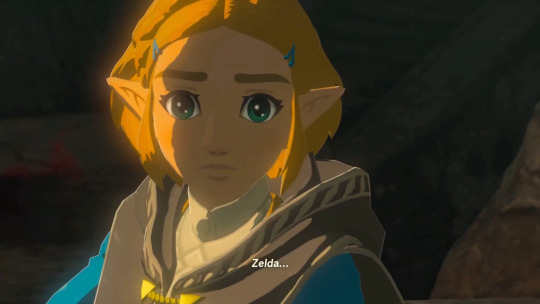
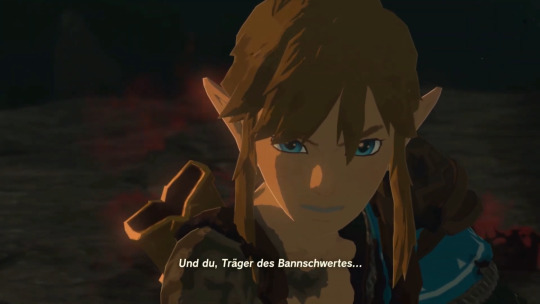
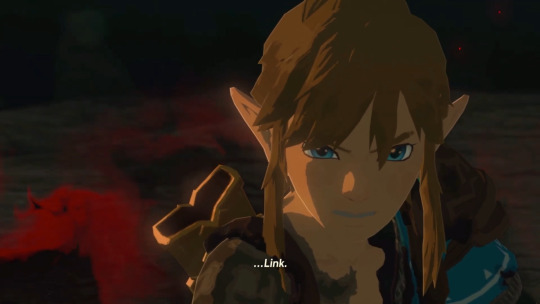
Translation: Zelda... And you, wielder of the banishing sword... Link. English Localization: Zelda... You who carries the fragile sword... Are Link.
Ganondorf explicitly draws a connection between Zelda and Link in German (not in the romantical sense), which feels much more natural than this kind of jump he does in English.
On a somewhat unrelated sidenote, I like that the camera shows both Zelda's and Link's reactions to Ganondorf knowing their names (unfortunately, I couldn't capture Link's because the subtitle vanishes just before he reacts, and I don't want to overload this post with pics, so... Go watch the scene again 😆). Love that Link has a very obvious reaction too, I feel like he is generally pretty expressive in TotK, which I very much enjoyed!

Translation: Rauru's grand prophecy... English Localization: Rauru placed his faith in you...
This is an interesting difference to me, because while both lines pretty much mean the same, the connotation (implied meaning) and tone are completely different.
In English, Ganondorf sounds like he is almost blaming Link and Zelda for not fulfilling Rauru's expectations, especially when combined with the next line.
In German meanwhile, this is more of a sarcastic comment, that expresses Ganondorf's disdain of Rauru more than anything else. Tilo Schmitz delivers this line with a very sarcastic undertone as well, making it clear that Ganondorf is, much like in the previous lines, mocking both Link and Zelda, as well as Rauru.
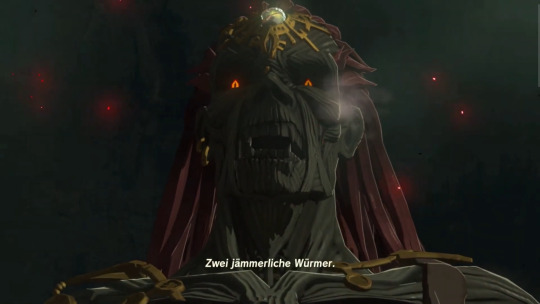
Translation: Two pathetic worms. English Localization: And that was all that you could do?
Now, there is a big difference! Whereas Ganondorf's line sounds almost like a challenge in English, in German, he is ourtight insulting Link and Zelda.
Also, Tilo Schmitz is amazing as Ganondorf in general, but this is probably my favorite line in the entire game from him. It sounds impactful, it sounds arrogant and despising, it has everything this line should have and more. Most of all, it sounds like he actually means this, and he means it as the character Ganondorf, not just as someone playing Ganondorf (from a meta perspective) or just anyone who can't stand Link and Zelda. It is a perfect line in my opinion, both scriptwise and delivery-wise.
Aaaaand that's pretty much it for this scene! Like in the English localisation, Zelda asks how Ganondorf knows their names (and Julia Casper makes her sound more timid than confused, which I also like very much!).
Anyway, thank you so much for reading 😊 Honestly, I was pretty overwhelmed by the response to my first posting about the German localization of TotK, so I wanted to wait a bit for things to calm down a bit 😅 In the 10+ years I've been on the internet, nothing I've made before has gotten this level of attention. It makes me very happy you guys seemed to enjoy it so much though, and I hope you enjoyed this one as well.
Have a great day, night, whatever time it is when you're reading this, and enjoy the game!
#The Legend of Zelda#LoZ#Tears of the Kingdom#TotK#Localization#German dub#Analysis#Meta#LoZ Analysis#LoZ Meta#TotK Analysis#TotK Meta#Ganondorf#Tilo Schmitz#Link#Zelda#German#Currantlee here#Currantlee translating#Currantlee analyzing
102 notes
·
View notes
Text









something something Red isn't that helpless and innocent like we think at first
#four swords#four swords manga#red link#loz#i swear he's cappable of commiting crimes and im not joking here#i know that his characterization in the manga makes him look very sweet and pure#and he is... but is not all that#someday i could go in a whole analysis of why i think this but that will take time#layraket art
324 notes
·
View notes
Text
Ooh, fascinating! I wonder if this has anything to do with it:


I think the condition of the blade makes a huge difference. But it’s really, really interesting to compare the “drawing of the Master Sword” moment throughout the games. After all, by our chronology, Legend was the first to do it!
The Master Sword doesn't seem to prefer Legend over other Links.
In fact, he is one of the few Links who needs to show his credentials before he can grab the Master Sword. Yes, you can find the sword before you get the pendants, it won't move until you have them.

Meanwhile, Twilight walks in, cursed, and the sword is like "yep, he is my master"

62 notes
·
View notes
Text
a lot of people have already pointed out how totk has a lot of themes of imperialism and generally leans conservative ideologically, but what i think is interesting is how totk subtly redefines what a “researcher” is.
zelda wants to be a researcher in botw, and what this means in the context of botw is largely someone who works with sheikah technology. she wants to figure out ancient sheikah tech, she has an interest in botany and otherwise nature and biology (the whole silent princess and the frog thing), robbie and purah, the two characters who are the closest to us seeing what a researcher in the context of botw is are basically inventors. in totk, however, the main researchers who are presented to us are all historians.
this is an interesting pivot, because in botw zelda is not really interested in history. if anything, the one who’s deeply concerned with history is rhoam, wanting to preserve historical tradition and his uncritical reliance on said tradition and historical precedent is what leads them to their doom. in botw, zelda is narratively opposed to history, if anything, all the ancient tech backfires on them and traditions fail to awaken zelda’s power. zelda’s urge to be a researcher is in wanting to understand the world around her, not just blindly follow ancient plans but rather have agency within them.
totk, however, is obsessed with ancient plans. the only real moment where zelda gets to geek out in totk is her getting all giddy about finding out more about the divine origins of hyrule. all the researchers in the game are concerned with finding out more about the zonai. since all the mentions of ancient sheikah technology are scrubbed from the game purah and robbie read more as strange outliers, the sheikah slate is no longer, now it’s the purah pad, a product of purah rather than something larger. the whole game is literally about following an ancient plan, a plan most characters don’t fully understand as they sign up for it. totk’s main story is built on confusion, on the characters not knowing what’s fully going on but having faith in ancient sages telling them what to do. in botw, following ancient plans you don’t fully understand was the thing that doomed you. in totk, following ancient plans you don’t fully understand is the gimmick.
that juxtaposition between the two games has an ideological through line: botw posits that progress is necessary. mindlessly relying on tradition doesn’t work. prophecies are omens, not instructions. history must be learnt from, not repeated. the ancient sheikah aren’t a group to be emulated, but rather to be learnt from, considering their machinery backfired and the royal family betrayed them. totk, however, is obsessed with the mythical history of hyrule, a time where everything was idyllic until one bad man showed up, a time we must emulate in order to win. i already talked about how the past in totk is zelda’s life pre calamity but better here, but that also plays into the idolisation of that era and its royalty. in botw, even the myth of the first calamity preserves the fact that the yiga clan has origins in the royal’s family persecution of the sheikah, even the time when they successfully held back the calamity is tinged with mistakes that still affect the world ten thousand years later. in totk, ganondorf’s origins are nebulous. nobody provoked him, nobody did anything wrong, he’s just evil because he is.
a lot of right wing ideologies are hinged on preservation, but more than that: the belief in the nebulous mythical past in which everything was better. “make america great again”, the fascist’s idolisation of ancient rome which is represented largely inaccurately, look at any conservative rhetoric and you’ll see people complaining about how things nowadays are ruined or are being ruined, how in the past things were this way and they’re not anymore, which is bad. the belief in the fact that in some past period we were great and are not anymore, and the strive to emulate that past is a trait highly typical of right wing ideologies. and in totk the past as a great era is an idea presented completely uncritically, the narrative is entirely controlled by the game and doesn’t dwell on any of the inconsistencies in this idea.
now, obviously, not every story in which a great ancient era exists is fascist, right wing or conservative. but to me what’s interesting specifically in totk is this shift between the two games: botw is critical of the past. it’s critical of arrogantly repeating history, it’s critical of having blind faith in great relics of the past. totk isn’t. totk idolizes the past, totk tells legends and tells you to believe them without any doubts. botw believes researchers are those who seek to understand the world, innovate it and solve problems without relying on ancient ways. totk believes researchers are those who discover ancient instructions, ancient ways and relay them to great men in the present to be followed. the four mainline regional quests in botw are about discovering four ancient relics that are terrorising the land and fixing the mistakes of the past. the four mainline regional quests in totk are about discovering four ancient legends are true, and receiving instructions from an ancient sage on what to do.
totk is not simply neutral, it is ideologically conservative in stark contrast to botw, because of the things it chooses to leave uncriticised, notably the things botw was very poignant about examining critically. the way totk redefines what is a researcher is indicative of this, indicative of the way it chooses to idolize or present as an unexamined good that which was nuanced in botw. totk isn’t just conservative in the sense that it presents uncritically a “good king” and “evil conquerer”, it goes deeper, it’s notable because botw was starkly opposed to the thematic axioms totk presents.
i just think it’s very interesting that they made a sequel to botw, and completely redefined or otherwise ignored botw’s thematic core.
#totk critical#loz#botw#totk#legend of zelda#tears of the kingdom#breath of the wild#meta#analysis#my hot takes
2K notes
·
View notes
Text
HI, CAN I TELL YOU ABOUT THE AKKALA CITADEL?????
Yes? Wonderful. Come, friend, have a seat. I have...a lot to say lol
Eight years later and I am STILL not over how absolutely genius this fortress is, like are you kidding me????? Everything from location to design to its inside defenses is just *chef's kiss* PHENOMINAL, and so because I have no filter, I am going to barf all my thoughts I've had on it in the past many many years.
Before we begin, shoutout to the WONDERFUL video by Zeltik that touches on this a bit and gave me a wonderful basis for my brainrot in the first place. Definitely go and watch it it's fabulous NOW! Let's get into the madness shall we? First let's talk about the location cos OHHHH MY GOSH. This was, hands down, THE best place they could have possibly put a fortress of this magnitude in Hyrule and I am going to tell you why. First of all, allllllll along the northern and northwestern border of Hyrule, there's those massive canyons
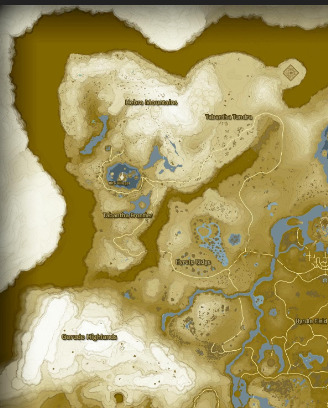
Passing over that in a way that would be effective military-wise is kind of impossible, so it provides a natural defense from invaders from those directions.
If you were to come from the South, you would hit the Gerudo desert and not only have to face the might of the Gerudo military, but also cross this EXPANSIVE, scorching desert before you can even make it to Hyrule field, and by that time, the royal leader could have very easily sent an army to intercept anyone trying to attack, so that's right out.
Which leaves coming from the Faron region next which is okay??? I guess??? but that's a LOT of swamp and forest you have to cross through, AND you go right past the Great Plateau where any army would have been seen and intercepted eventually. This takes us closer to the eastern coast of Hyrule, and you would be hard pressed to try and travel through Necluda, cos just l o o k at all these mountains you'd have to cross:

Horrible. And you probably don't want to go through Zora's Domain cos that's yet another heavily fortified and well prepared city in and of itself (please ask me about this one too I beg of you I love talking about Zora's Domain)
Any military leader with a brain isn't going to go through Death Mountain for obvious reasons, so really, all that leaves is this tiiiiiinnnyyy vulnerable spot in Akkala
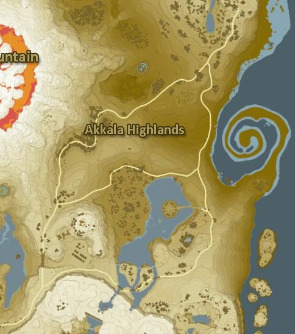
And where did they put the citadel??? Right at the heart of that vulnerable spot >:D Like a boss.
AND SO! if invaders came in from that coastline, they have three options: They can take the path through the Akkala Highlands, they can go through the Torin Wetlands and up to the pass it connects to, or they can take the trail up to the Sokkala Bridges. All of these are TERRIBLE OPTIONS Akkala Highlands path: If they come up this way at the start
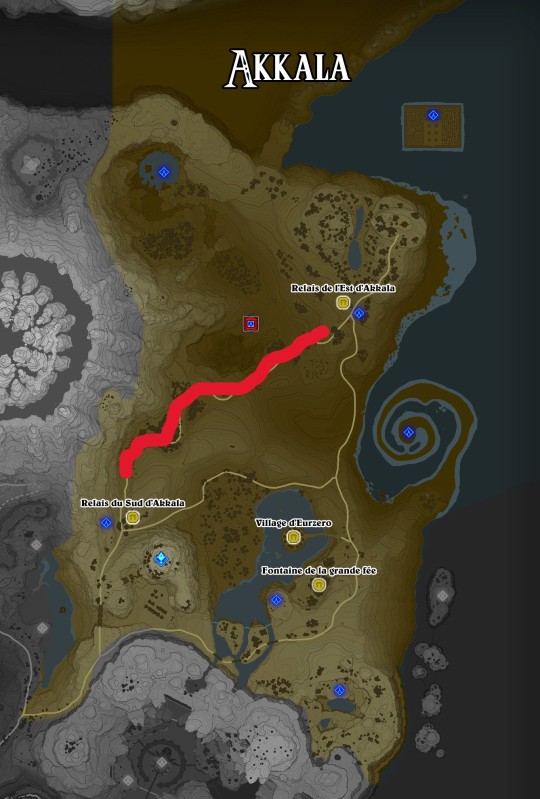
this will work allll the way until they get about here:

once they get here though, you are now not only bottlenecking an entire army meant to invade a kingdom (so probably roughly 1,000-1,300 people), but you're also directly under the shadow of the Akkala Citadel. There are archers there to fire on you, and they had a canon post on that side to potentially fire either at the incoming soldiers or fire at the opposite canyon wall to rain debris and rocks on them.
TERRIBLE for the other army.
And even if some did manage to survive, it would be painfully easy for the infantry at Akkala Citadel to send foot soldiers down below to cut them off.
SO THERE GOES THAT OPTION (and admittedly, I think it's probably the worst of the three)
Next option is to go through the Torin Wetlands and up into that same pass by the Citadel
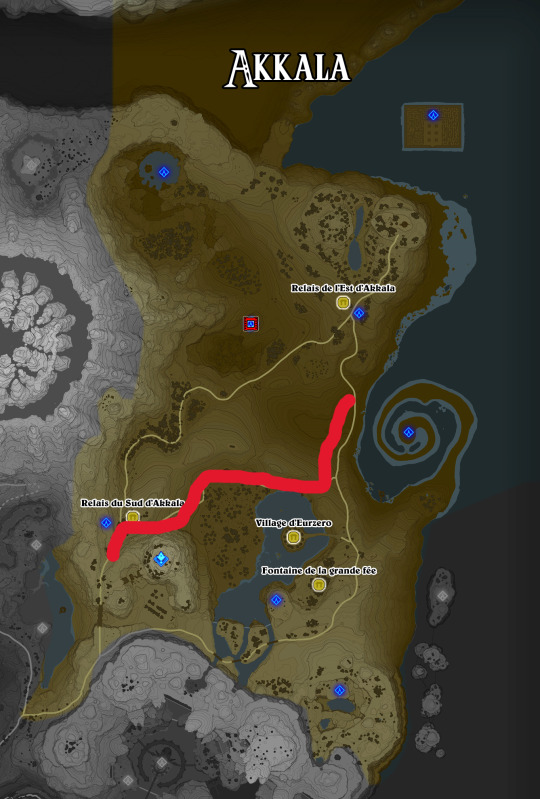
this is ALSO a bad idea because the Torin Wetlands are a DELIGHTFUL tactical advantage for Hyrule. Once you get to that pass, you have the same problems as option one, but now you first have to pass through this wide marshland to get there. This will immediately slow down your army, and if that wasn't bad enough it's also in clear freakin view of the citadel and so they would be able to send their entire militia of archers and potentially even cannoneers to fire on the advancing army and take a bunch of them out before they could even make it to that pass.
So a smart general may say the best option is to go around the long way.

now this eliminates the pass and also slowing down at the marsh, and you could even make it almost all the way to the citadel without hardly any losses probably BUT! The first hurdle is those bridges. Wonderful for Hyrule, terrible for the opposing army. The three Sokkala bridges are SMALL, even smaller than the pass an army would have to go through with the other two options. This military leader would basically have to send their soldiers single file unless they have a way to expand the bridges to make them wider (which, admittedly, could be possible with a bit of foresight, but for now for simplicity's sake let's just assume they didn't think that far ahead).
This brings in an EXTREMELY slowly advancing army right to the heart of the Akkala Citadel's battery.

There are three locations with canons we see in BOTW that cover pretty much the entire open area the opposing army would come in on. And when you look at the amount of space each post covered

There is not a SINGLE spot in that valley a cannoneer couldn't easily reach. And, of course they would continue to have archers to pick off individual soldiers as well.
And if SOMEHOW
BY SOME MIRACLE
enough soldiers make it through that hell to be enough of a problem, there are plenty more soldiers in the citadel to cut them off as they come up the hill AND IF THAT'S NOT ENOUGH! there was this:
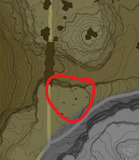
by the time we get to botw, it has been destroyed, but that is ANOTHER smaller stronghold that was probably pretty well manned in and of itself.
AND WHAT'S MORE

There's even this long cliff road with very little room to operate, so it would be extremely easy for the citadel to send over some soldiers to post up there and cut off anyone who tried to make it past. And with so little room to operate, it would not go well.
Ain't NOTHING getting past the Akkala Citadel, guys.
And that isn't even touching on the fact that the whole thing is build of solid stone??? And carved into a mountain??? The entire reason it fell in the first place was because the Guardians had enough of fire power to destroy the citadel that they had never seen before (also they could climb walls but that's a side note). This implies that no one in Hyrule or the neighbouring kingdoms had even CLOSE to that level of destructive power, so to try and raze it to the ground would have been impossible.
AND!! it was the most heavily fortified fortress in Hyrule second to the castle itself, and to most likely their military personnel would have been equal too, if not slightly more than even Hyrule Castle. That's A LOT of people!! With most likely endless support and resources from the castle and villages nearby as well.
It was placed geniously, it had impenetrable defense, it had a potentially endless supply of resources and people to use said resources, it was just
argjfbdkjgbks You guys don't understand how much I THINK about this place aghhhhhhhhhh
#akkala#akkala citadel#rant post#loz botw#breath of the wild#botw lore#legend of zelda: breath of the wild#legend of zelda#Nico's Zelda Location Analysis
232 notes
·
View notes